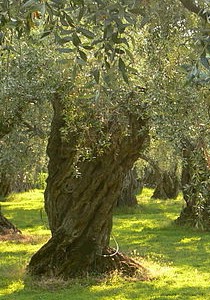 Grown for thousands of years in the Mediterranean region, the common olive is a small evergreen tree that can be successfully grown for fruit or as an ornamental in areas like California where summers are hot and winters are mild and wet. Olive trees are disease free, heat and drought tolerant, grow slowly but can live for hundreds, perhaps thousands of years, and become broad and gnarled with maturity. They are a member of the Oleaceae family that also includes lilacs, jasmine,and forythia. The narrow, leathery leaves are up to three inches long and have grey-green tops and silvery white undersides. Clusters of tiny fragrant yellowish flowers are produced in summer and are followed by edible, attractive green fruits that ripen to black in the fall if conditions are favorable. Olives need hot summers but a 2-3 month chill period (below 50 degrees) in the winter for optimum production of flowers and fruit. There are many cultivars available that vary in growth characteristics, climate requirements, and appearance of the plant, as well as the quality of the olive oil that can be produced from the fruit. Some cultivars, such as ‘Fruitless’ and ‘Swan Hill’ are grown solely for their ornamental value. The genus name, Olea, comes from the ancient Greek word ἐλαία, the ancient name of the tree. The specific epithet, europaea, is the Latinized name for Europe, the native habitat of the tree.
Grown for thousands of years in the Mediterranean region, the common olive is a small evergreen tree that can be successfully grown for fruit or as an ornamental in areas like California where summers are hot and winters are mild and wet. Olive trees are disease free, heat and drought tolerant, grow slowly but can live for hundreds, perhaps thousands of years, and become broad and gnarled with maturity. They are a member of the Oleaceae family that also includes lilacs, jasmine,and forythia. The narrow, leathery leaves are up to three inches long and have grey-green tops and silvery white undersides. Clusters of tiny fragrant yellowish flowers are produced in summer and are followed by edible, attractive green fruits that ripen to black in the fall if conditions are favorable. Olives need hot summers but a 2-3 month chill period (below 50 degrees) in the winter for optimum production of flowers and fruit. There are many cultivars available that vary in growth characteristics, climate requirements, and appearance of the plant, as well as the quality of the olive oil that can be produced from the fruit. Some cultivars, such as ‘Fruitless’ and ‘Swan Hill’ are grown solely for their ornamental value. The genus name, Olea, comes from the ancient Greek word ἐλαία, the ancient name of the tree. The specific epithet, europaea, is the Latinized name for Europe, the native habitat of the tree.
Type: Small evergreen tree
Outstanding Features: Fruit, leaves, gnarled trunk
Form: Rounded and gnarled with age
Growth Rate: Slow
Bloom: Clusters of tiny yellowish, fragrant flowers in summer
Size: 20-30’ H x 15-25’ W
Light: Full sun
Soil: Fertile, moist , well-drained; tolerates lean soil; drought once established
Hardiness: Zones 8-10
Care: Low maintenance
Pests and Diseases: None of significance but susceptible to scale, root rot and verticillium wilt.
Propagation: Cultivars from cuttings or by layering
Outstanding Selection: ‘Manzanillo’ (attractive and good fruit production).
